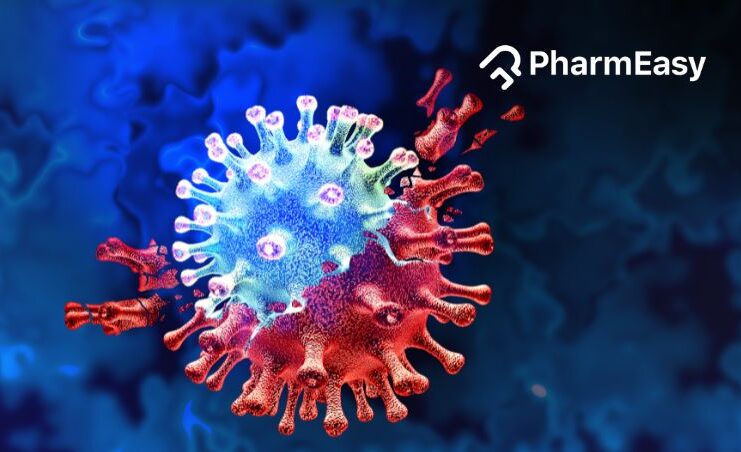JN.1 COVID Variant Hits India! Here’s Everything You Need to Know!
By Dr. Nikita Toshi +2 more

Get,

to manage your symptom
Get your,


4 Cr+ families
benefitted

OTP sent to 9988776655



You’ve successfully subscribed to receive
doctor-approved tips on
Whatsapp

Get ready to feel your best.

Hi There,
Download the PharmEasy App now!!


Register to Avail the Offer
Send OTPBy continuing, you agree with our Privacy Policy and Terms and Conditions

Hi There,
Sign up on PharmEasy now!!
Trusted by 4 crore+ families

OTP sent to 9988776655



You have unlocked 25% off on medicines




Code: NU25
By Dr. Nikita Toshi +2 more
Table of Contents
As of May 2025, India has reported 257 active COVID-19 cases, mostly mild and not requiring hospitalisation. This recent rise is mainly linked to the JN.1 variant, a subvariant of Omicron BA.2.86, which has been spreading across several Asian countries, including Singapore, Hong Kong, and Thailand.
First identified in August 2023, JN.1 is noted for its higher transmissibility and ability to evade immunity partially. The World Health Organisation (WHO) has designated it as a Variant of Interest due to these characteristics1.

Explore with us the unfolding narrative of this new COVID variant and its potential impact.
Any virus, including the COVID-19 virus, mutates over time for mainly two reasons.
These reasons create new variants of a virus.
The JN.1 variant of COVID is structurally similar to another older variant of Omicron that the CDC has been studying since August 2023, called BA.2.86 or the pirola variant2. Some minor mutations of the spike protein differentiate JN.1 from BA.2.86.
The novel coronavirus mutates at least four times more slowly than other RNA viruses like the influenza virus. This means that fewer new variants show up every year. There also don’t seem to be many antigenic changes in the coronavirus mutations (when mutations lead to antigenic drift and antigenic shift, human immunity can’t recognize and fight the virus even if the person is vaccinated).
That means the current COVID-19 vaccines will continue to shield the population from the circulating variants³˒⁴. People will still catch the infection when exposed to the covid virus, but vaccines may help reduce the severity and hospitalizations in most cases.
Global research organizations continue to remain vigilant and study the mutations and the efficacy of the existing vaccines against them³˒⁴.
In terms of transmissibility and mildness of symptoms, JN.1 is similar to the Omicron variant- BA.2.862.
JN.1. spreads the same way as any other COVID variant- through respiratory droplets of infected people. The virus can enter a healthy human being when the person inhales the respiratory droplets or touches anything that was recently touched by an infected person who had sneezed or coughed into their hand and left the virus on the surface.
JN.1 appears to continue the trend of new variants being highly contagious but causing infections that are not severe. It may cause serious illness and death in high risk population.
The symptoms usually go away within 5 days and may vary from person to person.
Breathing problem is not a common symptom of JN.1 and has been observed in some people with pre-diagnosed respiratory disorders. Consult a doctor and get tested if you fall sick.
There is no evidence yet that JN.1 is more dangerous than the other variants, but with further studies, this notion will become clearer.
Since JN.1 COVID cases may start spreading and we don’t yet know how rapidly this will happen, we should all be cautious. We have to resume practising COVID hygiene:
COVID variants are here to stay, and just like the flu, there will be flare-ups of cases from time to time. That is why it’s crucial to be hygienic and responsible and to follow healthy practices like eating nutritious foods and working out regularly. There is no need for panic, and we should adhere to the instructions of our doctors, healthcare bodies and governments.
Disclaimer: The information provided here is for educational/awareness purposes only and is not intended to be a substitute for medical treatment by a healthcare professional and should not be relied upon to diagnose or treat any medical condition. The reader should consult a registered medical practitioner to determine the appropriateness of the information and before consuming any medication. PharmEasy does not provide any guarantee or warranty (express or implied) regarding the accuracy, adequacy, completeness, legality, reliability or usefulness of the information; and disclaims any liability arising thereof.
Comments

Leave your comment...
You may also like
Comments